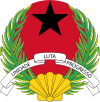Flag of Guinea-Bissau
 | |
| Use | National flag and ensign |
|---|---|
| Proportion | 1:2 |
| Adopted | 1973 |
| Design | One vertical red line on the hoist side charged with a black five-pointed star; two horizontal lines on the fly side (yellow and green) |
The flag of Guinea-Bissau was adopted in 1973 when independence from Portugal was proclaimed.
Design
Like the former flag of Cape Verde, the flag is based on that of the Partido Africano para a Independencia da Guine e Cabo Verde (PAIGC), still the dominant party in Guinea-Bissau. The party flag was derived from that of Ghana, which first used the Pan-African combination of red, yellow, green, and black in 1957.
In the Ghanaian view, the black star stands for the unity of Africa. Red stands for the blood shed during the struggle for independence, yellow stands for the sun, and green represents hope.
The flag features the traditional Pan-African colors of gold, green, red, and also the Black Star of Africa. The flag's design is heavily influenced by the flag of Ghana. The colors have the same meanings: specifically, the red is for the blood of martyrs, green for forests, and gold for mineral wealth.
See also
References
This section needs expansion. You can help by adding to it. (December 2014) |

